CLEER Medical’s Mini Blowout Kit or MBOK comes in at only 5″ x 3.5″ x 1.75″ and 8.2 oz, fully loaded. CLEER worked directly with Celox, North American Rescue, and 3M to obtain proprietary-sized and packaged components in order to achieve the MBOKs small size and weight.
The MBOK is a two-part system consisting of an inner wallet that holds the kit contents, and an outer sleeve that allows the contents to be deployed with either an upward or downward pull, utilizing no buckles, snaps, or hook-and-loop. The outer sleeve uses Blue Force Gear’s Helium Whisper PALS attachment system.
The CLEER Medical MBOK comes with the following:
• CLEER Medical Trauma Bandage (4″ x 24″ Flat Packed compression dressing)
• Celox Rapid (3″ x 24″ Z-Fold)
• FOXSeal Occlusive Dressing (Contains 2 Chest Seals)
• North American Rescue Tan Bear Claw Gloves (1 Pair of Large sized gloves)
• CLEER Medical Easy Tape (4 – 2″ x 12″ Strips of 3M Durapore medical tape on easy release backers)
• North American Rescue ARS for Needle Decompression (14 gauge x 3.25″) – Advanced Version Only
• Rusch Nasopharyngeal Airway (28FR with lubricating jelly) – Advanced Version Only
CLEER Medical is currently taking pre-orders for the MBOK, with an estimated ship date of July 7th, 2014. Color options: Black, Coyote Brown, and MultiCam.
Manufactured in the USA by Blue Force Gear.
Tags: Blue Force Gear, Cleer Medical LLC


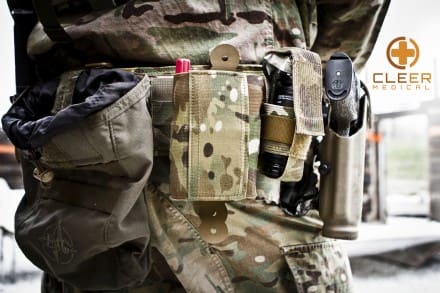
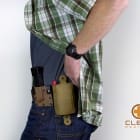
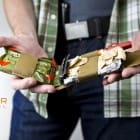
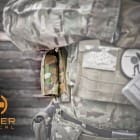
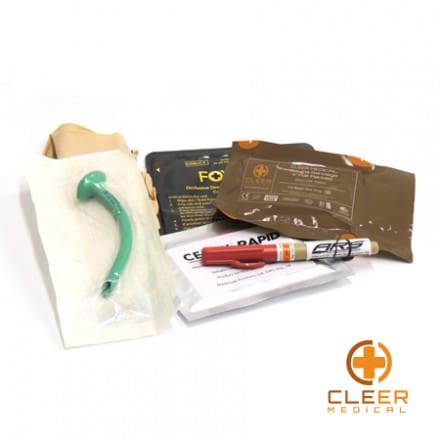
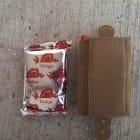
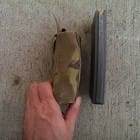
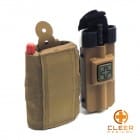
Looks very interesting, but the $329.99 price tag seems a little high for a BOK.
I love the look of this, but the price is OUTRAGEOUS. It looks like it would fit nicely on a LEO duty belt.
It appears that it only comes complete with the contents, and at $249…with the refill costing about $139…they’re valuing the pouch at $110?!
I’d like to buy just the pouch, but I would hesitate to pay half of that…and I’m quite serious about my gear. That makes me wonder how well these will do in the market.
I’d imagine that a significant portion of the cost is the BFG piece(s).
As an example, their HW Large GP Utility is $80 (before the Pro discount). Competing (“equivalency” is subjective) product (from a reputable on-shore manufacturer like ATS) comes in at less than $60. And there’s a Kifaru product with simpler mounting and far less internal organization that comes in at under $50.
Someone who jobs product to BFG is gonna pay full boat for the IP of the HW mount and another premium for a smallish manufacturing run.
Add to that the 5-row-high components–again, smallish runs of medical technology still amortizing development costs–and you’re getting into money.
And then there’s the folks who designed the system in the first place. Even people who love doing good work deserve to be compensated fr it.
Doesn’t make the price one bit easier to absorb for a Good Guy (or Gal) who wants the the capability of a larger and bulkier kit at the ready on the outside chance that s/he’ll have the chance to turn the Last Minutes of Someone’s Life into the Worst Minutes of Someone’s Life.
…and could use this kit within the scope of heir training (if not their duties)…
…and could STILL get sued…
It’s Hypalon, not diamonds made into a flat piece. Hypalon is what? $30/yard if you pay out of your ass for it.
Their Helium Whisper design eliminates many steps in the production, making it on par with prices of the traditional type attachments (honestly I think it’s even cheaper). Laser cutting eliminates waste, making you able to get just a few square inches of waste material if you plan your stuff properly (as I’d expect BFG to do).
The sleeve is a HW piece, and a piece of elastic or two, and some Cordura on the front.
The insert is a Hypalon piece and some elastic sewed onto it.
There isn’t a high material cost, I’d guess something like $2-4 in materials, the rest is labor/licensing.
I’ve never worked with BFG, but another brand I worked with (and most other cut and sew places) have a 25 pcs minimum. I wasn’t charged some outrageous sum of money for the product, it was a lot cheaper than what I was able to build them for.
If I was Asian and into copying peoples work, I would still have a cheaper pouch than $110 with my Norwegian hourly rates…
If I were Norwegian I’d make assumptions without first hand knowledge. This is a small company starting up, having their own proprietary medical dressings produced by industry leading companies, using BFG’s Helium Whisper material, which ain’t just Hypalon (if it was, then how’d BFG license it and why isn’t everyone using it?), and having all made in the USA. That’s expensive to do, especially in the beginning. And no, I do not work for CLEER. Just tired of people being negative about stuff they have never used or even seen up close.
HANK-familiy of fabrics (that’s Hypalon), is the same stuff all over the world.. It’s like “Cordura”. Just because you call it Ultracomp (trademarked name belonging to BFG) doesn’t change the fabric structure.
Guess what, the supplier to BFG might even be Trelleborg, a Swedish owned company…
The reason everyone isn’t using BFGs HW design is that most people and companies manage to figure out their own version eliminating the need to pay someone else. WTF made their own, open source version called PALSecure; http://www.wtfidea.com/components/
It’s just like some companies used the Natick snap (and paid royalties to BAE), while others came up with their own.
I’m happy for CLEER, this looks like a great design (the medical stuff itself is outside of my league). The price for the pouch however, strikes me as an overpriced product because of the simplicity (that’s from a production point of view, not use). It simply doesn’t end up at $110 unless you mark it up by ~100%.
But what do I know, I’m just a stupid Norwegian who lives in a mudhut.
Looks pretty nice, but on the border of being too small/not having enough. Also their price is extremely high… Makes me feel better about paying what I did for my Mayflower LVBOK.
They need to do some market research regarding competitors product pricing as this rig is way too expensive.
????? Way to much $! Atleast offer it without the contents… This really would feel a much needed niche in the market and help out patrol officers. To bad they made it out of reach for us regular joes…
If they offer it without the contents, then people would see that they are charging well over $100 for a tiny pouch.
This is a pretty slick design, but I am also confused by the price. It seems to me that a BFG trauma kit now! and a double 10-speed mag pouch represent the materials and man hours required to make at least 2 of these pouches and only cost $120 together, so I would think these should cost in the $60 range (plus the cost of contents). Even with a markup $110 seems a little unreasonable, even from a supply perspective.
Speaking of which, BFG should totally make a mini TKN! I bet it’d cost $70 or less.
Or you can get the ITS kit for way way less
I like the smaller medical gear, but 24″ will barely make one wrap around a thigh. Chest seal and celox ok, especially for LE ,but the bandage would be an upper extremity maybe lower leg bandage at best.
Blow out kits are like cell phones. At firs they are huge. Then there’s the push to make them as small as possible with lots of features. Price increase. Now phones are going big screen again, as I’m sure the blow out kits will too. The prices are still skyrocketing.
Blow out kits are like cell phones. At firs they are huge. Then there’s the push to make them as small as possible with lots of features. Price increase. Now phones are going big screen again, as I’m sure the blow out kits will too. The prices are still skyrocketing.
There is a market for this, which is why it was made. I’m sure there are plenty of government agencies which will be purchasing these. Unfortunately the price range is out for us plebeians who purchase kit to supplement issued kit that is insufficient.
Why does the dart have to stick out?
I have said this before on forums, and given the copious grousing about the price point of a brand-new, revolutionary product, it bears repeating here:
The CLEER MBOK is the smallest and lightest comprehensive gunshot wound trauma kit on the market, by a wide margin. For a frame of reference, it is approximately the same size as a Klondike Bar, and weighs only eight ounces. The kit’s inner “wallet” fits perfectly in the front thigh pocket of a pair of Crye pants.
There are no buckles, snaps, fasteners, or hook-and-loop to mess with in order to deploy the contents of the pouch. The pouch is completely secure and jumpable, yet one upward or downward pull on the pull-tab quickly deploys the inner “wallet.”
Most “low-vis” kits achieve a small-ish size by putting everything into an outer package and vacuum-sealing it. This helps reduce size, but adds another layer to cut through in order to administer first aid. Other kits simply contain fewer essentials. Or they contain less AND are vacuum-sealed. With the CLEER kit, other than the packaging of the individual components, there are no vacuum-sealed bags used to shrink the size of the kit.
Using off-the-shelf components, there is a finite limit to how compact and lightweight a kit can be made. The size, weight. and form-factor of kit components are largely driven by the purchasing requirements of the DoD and EMS community, and these entities have been content with bulky items so long as they were effective. As a result, CLEER had to invest substantial time and money to research how small these components could be made and still retain efficacy. Let me tell you: the reason smaller components haven’t existed up till now is because no one was willing to front the money (it’s a SUBSTANTIAL amount) to have them made. We stepped up and made the investment.
Like cutting-edge consumer electronics, ultra-light multi-hit rifle plates, and hybrid cars, this is a new technology, and will be more expensive than kits presently on the market at first due to the cost of development. However, for those who truly need a comprehensive blow-out kit for low-profile and no-profile missions, there is nothing else that fills this niche. Considering that the issued IFAKs for the various branches of the US Military run anywhere from $215-$265, and commercial trauma kits range in price from $120-$200, paying a small premium in order to have a kit this capable that is low-vis and ultra-light does not seem terribly unreasonable — ESPECIALLY since, in addition to making everything so small, we took the time to design what we feel is the most innovative BOK pouch on the market. At SHOT and during numerous meetings with various military units and LE agencies, nearly everyone who saw this kit in person was floored by how small it is. Furthermore I don’t know of anyone balking at the price once they had a chance to handle it in person.
The custom compression dressing (which is actually made and sterilized in the USA), custom-sized Celox Rapid, and some of the other custom-sized and packaged products we have developed (or are developing presently) cost a lot more than their full-size counterparts. The minimum opening order just for us to get these items made was HUGE, and there’s no way for me to buy them any cheaper unless I order in even larger quantities.
Not everyone can or will be an early-adopter. Not everyone can justify the cost of a Crye JPC or Quad-Tube NVG’s, but my experience with civilian consumers is that those who want or need the product badly enough will forgo buying some other personal luxury in order to afford it. On the .mil/.gov side of the equation, squared-away military and LE guys who REALLY need it for their job will find a way to pay for it — either by finding the funds in their personal budgets, or by getting creative and finding a way to get their employer to pay for it.
Honestly, I don’t see $249 as being outside the budget of your average Joe. A Glock on the LE program is about $385. Body armor runs anywhere from $250-$800. A good-quality duty-belt or MOLLE “war belt” with holster and pouches will run around $350. The MBOK is every bit as life-saving as any of those other items, and priced competitively with them. Is it as cheap as a DRMO’d IFAK? Not by a long shot. But unlike that giant ACU pouch of near-expiration date contents, this kit will actually be ON the officer (rather than in the trunk or patrol bag) because it’s small enough to be worn.
When flat screen TV’s first came out, a “big” screen was 42″ and cost over $6,000. Just a few months back, I had to walk past dozens of 50″-60″ models to find and buy a “mid-size” high-definition LED 42″ flat screen for the RCS SHOT show booth, and it cost me just over $400. The longer something is made, the cheaper it becomes; that’s basic economics. If enough people opt to be early-adopters, the price will drop faster. However, if you don’t want to spend $249 on a trauma kit, there are LOTS of other options already on the market that cost less; they will just be two to four times the size of the MBOK.
I can’t state it enough: NOTHING else on the market right now can do what this kit does, which is deliver comprehensive blow-out kit capabilities in a package that’s concealable under an un-tucked polo shirt. For those that NEED this, nothing else can offer the same capabilities in such a small, light-weight form-factor.
Thank you for that excellent comment.
Thanks for commenting and sharing the development of the contents, which look fantastic.
I don’t think anyone was balking at the $139 price of the miniturized contents though, it was more the price of the $110 pouch that people were shocked by.
You have unfortunately priced yourself out of widespread adoption in your target market.
Hopefully you can find someway to subsidize it, and get it to the point where a soldier / street cop can afford to buy it versus a competitors product.
Bruce-
Based on the number of kits that have been pre-ordered just since Tuesday, I think I’m going to have to respectfully disagree with you. It has been very well-received by the market thus far.
As I said in my earlier comment, I don’t see $249 as being a financial barrier for serious professionals. After all, it is gear that is carried to save your life. When judged relative to the price of the other items that a cop or soldier uses to do his job, it’s actually not even in the top three most expensive items.
I think if we were all honest with ourselves, it’s not a question of “can average Joes *afford* this,” it’s a question of “will average Joes prioritize a trauma kit as ‘must-have’ gear?” I’ve seen plenty of guys who drove to the range in their Ford Raptor, break out a $2000+ M-4, and then put on OSHA safety glasses and foam ear plugs because he grabbed them for free at his factory job. Does this mean that guy can’t afford Smith Elites and Sordins? Or does he just prioritize other things besides premium eye/ear protection as more worthy uses of his money?
Like I said, if price is your primary criteria, there are hundreds of kits presently on the market that will fulfill your requirement of a less expensive kit; they will just be a lot bigger and heavier. But if the SIZE and WEIGHT of a COMPREHENSIVE kit is your primary criteria, the MBOK is presently your only option.
When almost every post on here and almost anywhere else is saying that you priced this too high for the market, and so much of your time is being spent on justifying the list price, what does that tell you?
My comments are meant to be helpful.
Comparing the technology of shrinking the weight and size of gauze to that of Quad-tube NVG, hybrid cars or HDTVs is not only illogical, but laughable. I understand the celox dressing being expensive, but the other stuff….Good luck, but no thanks.
-ATLS trained and certified emergency medicine resident physician.
Anyone knows who makes the flash-bang pouch in the first picture?
Have the custom sized medical supplies been approved by the Committee on Tactical Combat Casualty Care for issue/use by DOD?
Jason-
In response to “TCCC Approval Inquiries,” TCCC does not support a ‘by-name’ recommendation on kit contents other than Tourniquets (Extremity and Junctional), and Hemostatic Agents. They “recommend the use of” type of devices as a method of intervention.
Tourniquet: The MBOK utilizes a TCCC recommended TQ.
Hemostatic: TCCC notes “for compressible hemorrhage not amenable to tourniquet use or as an adjunct to tourniquet removal (if evacuation time is anticipated to be longer than two hours), use Combat Gauze as the hemostatic agent of choice.” But that is as far as is goes. This is from the most recent published guideline of 2013. http://www.usaisr.amedd.army.mil/assets/pdfs/TCCC_Guidelines_131028.pdf (page 3, Paragraph 4, Sec B). However, since then the Celox Family of Products has been approved by CoTCCC, but the formal revised current guideline has yet to be published. The press release can be found here: https://soldiersystems.net/tag/celox/
Pressure Dressings: Current guidelines DO NOT make mention of specific dressings in any intervention.
Chest Seal: In the TCCC3 publication “preferred features of chest seals 2013” They clearly state that they DO NOT recommend a particular chest seal.
Needle decompression: TCC3 DOES NOT recommend a particular brand of needle. “In a casualty with progressive respiratory distress and known or suspected torso trauma, consider a tension pneumothorax and decompress the chest on the side of the injury with a 14-gauge, 3.25 inch needle/catheter.” http://www.usaisr.amedd.army.mil/assets/pdfs/TCCC_Guidelines_131028.pdf (Page 2, Paragraph 3, Sec A.)
As per the Celox website FAQ:
11. How much is needed to treat a severe wound?
All wounds are different but the 5-foot gauze has been tested and stopped bleeding from a major artery, as has the 15 g granules. The larger sizes (10 foot gauze, 35 g granules) give additional security for more complex injuries or multiple wounds on one casualty.
With the CLEER MBOK you have changed the composition of two hemorrhage control items – the pressure bandage and hemostatic agent.
Anytime you change the composition of first aid items in an IFAK – they must be tested, evaluated, and determined to be effective for your purposes / established requirements.
Compression Bandage: Each wrap of the compression bandage equates to greater pressure (longer tails) which (along with a hemostatic) will slow and stop the bleed.
Hemostatics : Their size is contingent upon not only the amount of material needed to pack the wound, but also the amount of hemostatic agent carried by the material. Cutting the amount of material means also cutting the amount of agent.
Celox Rapid contains 9 grams of Chito-R. What amount of Chito-R does the custom CLEER MBOK Celox Rapid contain?
What testing has been done for the custom / reduced Celox Rapid gauze in the CLEER MBOK to determine the severity of wound(s) capable of being successfully treated? Has there been a test of it severe femoral artery bleeding rat model or multi-swine femoral arteriotomy?
I don’t see this as viable for Direct Action / CQB mission sets or even as a full IFAK for .mil purposes, but I could definitely see this as a system I would carry daily. What is stopping me from doing so are the lack of answers to the above. I will not carry a system that A) I can’t train with and B) that does not provide the science / testing done to validate the lifesaving capabilities of a product.